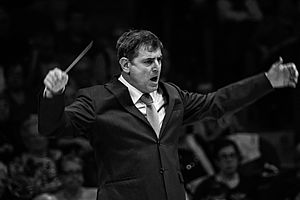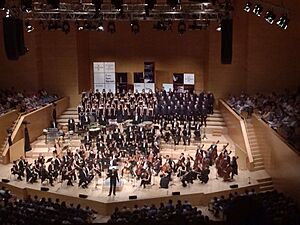Salvador Brotons facts for kids
Quick facts for kids Salvador Brotons |
|
|---|---|

Brotons in 2013
|
|
| Background information | |
| Born | 17 July 1959 Barcelona |
| Genres | Symphony, concerto, chamber, cantata, opera |
| Occupation(s) | Composer, flautist, conductor |
Salvador Brotons (born in Barcelona, July 17, 1959) is a talented Catalan musician. He is a composer, a conductor, and a flautist. He leads the Vancouver Symphony Orchestra in Vancouver, Washington. Since the 2022-2023 season, he has also been the main conductor for the Orquestra Simfònica Sant Cugat.
Salvador Brotons is known as one of the most important modern Catalan composers. His music is played all over the world. He has written over 170 pieces, including symphonies, concertos, and even a children's story. He likes to use clear melodies and traditional musical styles. As a conductor, he is very energetic and shares his passion with both the musicians and the audience. He also makes sure to include music by other Catalan composers in his concerts.
Contents
About Salvador Brotons
Early Life and Music
Salvador Brotons grew up in a family of musicians. His father and grandfather both played the flute. His father was his first flute teacher. Salvador studied at the Municipal Conservatory of Barcelona. There, he learned flute, composition (how to write music), and how to conduct an orchestra. He learned from famous teachers like Antoni Ros-Marbà and Xavier Montsalvatge.
When he was just 14, in the 1970s, Brotons started writing music. He mostly wrote for single instruments or small groups. One important piece from this time was Elegia per a la mort de Xostakóvitx (Elegy for the Death of Shostakovich) for piano. This showed his admiration for the Russian composer Shostakovich.
In 1977, when he was 18, he wrote Quatre peces per a cordes (Four Pieces for Strings). This piece won him his first big award, the Premio Orquesta Nacional de España. This meant his music was played by a national orchestra.
He also became a principal flautist for the Orquestra Simfònica del Gran Teatre del Liceu (1977–1985). Later, he joined the Barcelona Symphony Orchestra and National Orchestra of Catalonia (1981–1985) as a second flautist. He managed to do both jobs while still studying and composing.
In 1979, he won another award from Jeunesses Musicales International for young composers. This was for his work Simetries (Symmetries). In 1983, his first symphony won the Premi Ciutat de Barcelona. His Second Symphony also received an award in 1984.
Studying in Florida
In 1985, Brotons got a special scholarship called a Fulbright Scholarship to study in the United States. He went to Florida State University. This was a big moment in his career. He decided to focus on conducting and composing.
While in Florida, he became an assistant conductor for the Florida State University Symphony Orchestra. He wrote several new pieces, making his music stronger and more detailed. In 1987, his work Absències (Absences) won him another Premi Ciutat de Barcelona. This piece was based on poems by Miquel Martí i Pol.
Leading Orchestras in the U.S.
In 1987, Brotons moved to Portland, Oregon. He became the conductor of the Portland State University Orchestra and taught music there. During this time, he wrote important works like the Piano Quartet in E major. His piece Virtus won an award in the United States and later the famous Queen Sofía Composition Prize in 1991.
In 1989, he composed an opera called Reverend Everyman. It was shown on American television and was very popular. He also led the Oregon Sinfonietta and the Mittleman Jewish Community Orchestra for a few years.
Since 1991, Brotons has been the main conductor of the Vancouver Symphony Orchestra in Washington State. Under his leadership, the orchestra has grown a lot. It has gained more audience members and become more recognized. He has received awards for his work with the orchestra. During this time, he wrote larger pieces for orchestra and choir, like the symphonic poems Phaedo and Liliana.
Connecting with Catalonia
Brotons often returned to Catalonia, his home region. This helped him get important commissions and become more known there. His music became very popular in Barcelona, with new pieces being performed often. He made different versions of his music, like piano versions, to make it easier for more people to play and hear.
He also started to include traditional Catalan folk music in his compositions. This showed his love for his homeland. His piece Terres llemosines (Lands of Limousin) was one of the first to show this Catalan style.
In 1997, he became the main conductor of the Orquestra Simfònica del Vallès. He held this position until 2002. In 1998, he also became the main conductor of the Orquestra Simfònica Illes Balears (1998–2001). This meant he was leading three orchestras at the same time!
His music began to sound even more Catalan. He skillfully mixed traditional melodies with his own style. This made his modern music more appealing to audiences. Examples include his Six Catalan Rhapsodies and concertos like Mare Nostrum for guitar.
Under Brotons' direction, the Vallès Symphony Orchestra performed more often at the Palau de la Música Catalana, a famous concert hall. He also made sure to include music by other Catalan composers in his programs.
In 2000, his Stabat Mater was performed at L'Auditori and was very well received. In 2002, he left the Vallès Symphony Orchestra and the Balearic Islands Symphony Orchestra. His time with these orchestras helped them improve a lot.
In 2001, Brotons started a music publishing company called Brotons & Mercadal Edicions Musicals S.L. with his brother-in-law. Their goal was to help new composers and bring back older, forgotten pieces.
In 2003, his Concert Trobadoresc (Troubadour Concerto) for cello and orchestra premiered. This piece was based on old songs by troubadours. He also premiered a cantata called El viatge de Kira i Jan o l'arbre de les llengües (The Journey of Kira and Jan or the Tree of Languages). Over 11,000 children from Catalan schools performed this work.
In 2008, Brotons became the conductor of the Barcelona Municipal Band. He led this group for eleven years. In 2009, he returned to conduct the Orquestra Simfònica Illes Balears again until 2013.
In 2011, his Fifth Symphony, Mundus Noster (Our World), premiered. It was a very emotional and colorful piece.
In 2014, his symphonic poem Catalunya 1714 premiered. This piece was part of the events celebrating the 300th anniversary of the Siege of Barcelona in 1714. It tells the story of Catalonia's past, including folk songs and the National Anthem of Catalonia. Brotons said he wrote this piece with a lot of emotion.
Later in 2014, a musical called Fang i setge (Mud and Siege) premiered. Brotons wrote the music for it. It was a big production with many actors.
From 2016 to 2017, Brotons was the composer-in-residence at the Palau de la Música Catalana. In 2017, he premiered a cantata about the life of Ramon Llull called Cantata de Randa.
In 2018, he premiered his Double Concerto for Violin, Cello, and Orchestra. In 2022, his Missa per la pau (Mass for Peace) was performed for the first time.
Since the 2022-2023 season, Brotons has been the main conductor of the Simfònica de Sant Cugat. He continues to be very busy as a conductor and composer. In 2024, he received the Felip Pedrell Prize for his career and for promoting Catalan music. In May 2024, his Te Deum premiered at the Auditori de Barcelona.
Musical Style and Achievements
Brotons' music is different from some European styles. Instead, it connects with music from places like Russia (like Prokofiev and Shostakovich) and Hungary (like Bartók). He also uses influences from American symphonic music. This means his music often sounds grand, lively, and full of rich orchestral colors. You can hear hints of composers like Gershwin and Copland in his bright and colorful sounds.
Salvador Brotons has composed 143 works and made 16 recordings. He mostly writes for orchestras and chamber groups. He has received many awards throughout his career. These include:
- The Premio Orquesta Nacional de España in 1977 for Cuatro Piezas para Cuerdas.
- The Premio Ciutat de Barcelona in 1983 for his first symphony and in 1986 for Absències.
- The Southeastern Composers League Award in 1986 for Sinfonietta de Camara.
- The Madison University Flute Choir Composition Award in 1987 for Flute Suit.
- The Premio Reina Sofia de Composición in 1991 for Virtus of Orchestra.
His music has been released by well-known record labels like Naxos and EMI. Much of his music is published by his own company, Brotons & Mercadal. He has conducted orchestras in many countries, including Israel, France, Germany, China, and Mexico.
Personal Life
Since 2001, Brotons has also taught and conducted at the Escola Superior de Música de Catalunya. He is married to Melissa Mercadal, who is a flautist, psychologist, and music therapist. They have a daughter named Clara Brotons, who works in film production in New York.
Selected Works
Salvador Brotons has written a lot of music. Here are some examples of his works:
For Orchestra
- Four Pieces for Strings (1977)
- Symphony No. 1 (1981)
- Sinfonietta da camera (1985)
- Absències, for narrator and orchestra (1986)
- Symphony No. 3 (1992)
- Liliana, for narrator and orchestra (1993)
- Concerto for Flute and Orchestra (1996)
- Catalan Christmas Carols (1998)
- Symphony No. 5 Mundus Noster (2010)
- Catalan Rhapsody No. 5 Catalunya 1714 (2014)
For Choir and Orchestra
- Stabat Mater (1997)
- Ode to Verdaguer (2001) – a cantata for choirs and baritone
- History of a Millennium (2002) – a cantata for choir, narrator, and orchestra
- Cantata de Randa (2015) – for choir, orchestra, narrators, and solo singers
- Mass for Peace (2021)
- Te Deum (2022)
Stage Works (Operas and Musicals)
- Reverend Everyman (1989)
- Fang i setge (2014)
Concertos (for Solo Instrument and Orchestra)
- Concerto for Trombone and Orchestra (1995)
- Concerto for Violin and Orchestra (1996)
- Concerto Mare Nostrum for Guitar and Orchestra (1999)
- Troubadour Concerto for Cello and Orchestra (2003)
- Catalan Concerto for Tenora and Orchestra (2006)
- Concerto for Oboe and Orchestra (2010)
- Concerto for Piccolo and Orchestra Dialogues with Axel (2012)
- Double Concerto for Violin and Cello The Andorran (2018)
For Band
- Rebroll (1983)
- Sonata da Concerto for Trumpet and Band (1990)
- Catalan Christmas Carols (1997)
- Tribute to Puig Antich (2009)
- Catalunya 1714 (2014)
- Covid-19 Sensations (2020)
Chamber Music (for Small Groups of Instruments)
- Sonata for Flute and Piano (1979)
- Piano Trio Op. 39 (1986), for Violin, Cello & Piano
- String Quartet No. 1 (1978)
- Piano Quartet in E A Celebration of Life (1987)
- Virtus (1990), for Flute, Violin, Viola, Cello & Piano
- Flute Suite (1986), for 10 Flutes
Instrumental Music (for Solo Instruments)
- Elegy for the Death of Shostakovich (1975), for Piano
- Two Suggestions (1979), for Guitar
- Sonata for Piano (2011)
- Sonata Covid-19 (2020), for solo Viola
Sardanes (Traditional Catalan Dances)
- El Port de la Selva (1975)
- Les Encaixades (1983)
- Per a tu Catalunya (2014)
See also
 In Spanish: Salvador Brotons i Soler para niños
In Spanish: Salvador Brotons i Soler para niños



